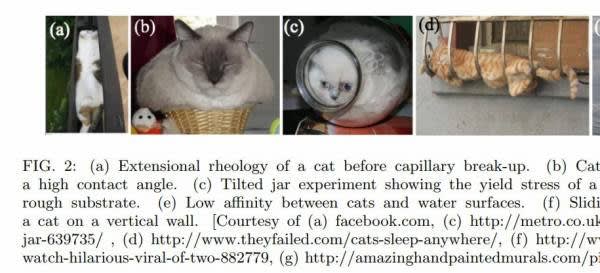
Science
Vampire bats, liquid cats and old men’s ears win Ig Nobel awards
 One prize went to research using fluid dynamics to determine whether cats are solid or liquid. Photo: Getty.
One prize went to research using fluid dynamics to determine whether cats are solid or liquid. Photo: Getty.Science’s most gleefully irreverent research was celebrated in an award ceremony at Harvard University on Thursday.
Every year the Ig Nobel Prize – whose name is a pun on the word ignoble – recognises ten pieces of research that “first makes you laugh, then makes you think”.
Studies that won prizes this year include a paper explaining why old men have big ears, research using fluid dynamics to determine whether cats are solid or liquid, and a report explaining why some people are disgusted by cheese.
Much like the real Nobel Prizes, categories include physics, peace and chemical engineering, but change year to year.
The work presented at the awards, organised by the Annals of Improbable Research, the scientific humour magazine, usually deals with serious issues but in humorous ways.
Marc Abrahams, editor of the magazine and founder of the awards, said: “If you didn’t win an Ig Nobel prize tonight – and especially if you did – better luck next year.”
Here are this year’s prize winners:
PHYSICS PRIZE — Marc-Antoine Fardin, for using fluid dynamics to probe the question “Can a Cat Be Both a Solid and a Liquid?”
(Yes, because of their ability to adopt the shape of their container.)
 An image from the paper ‘On the rheology of cats’ by M.A. Fardin.
An image from the paper ‘On the rheology of cats’ by M.A. Fardin.
PEACE PRIZE — Milo Puhan, Alex Suarez, Christian Lo Cascio, Alfred Zahn, Markus Heitz, and Otto Braendli, for demonstrating that regular playing of a didgeridoo is an effective treatment for obstructive sleep apnoea and snoring.
ECONOMICS PRIZE — Matthew Rockloff and Nancy Greer, for their experiments to see how contact with a live crocodile affects a person’s willingness to gamble.
Problem gamblers who felt excited about holding the crocodile made larger bets and felt more “lucky,” while those who felt negative about the croc handling were more cautious with their ----.
ANATOMY PRIZE — James Heathcote, for his medical research study “Why Do Old Men Have Big Ears?

pfk
He measured the ear length of more than 200 patients and discovered not only that old men have big ears but that ears grow about 2 millimeters per decade after age 30.
BIOLOGY PRIZE — Kazunori Yoshizawa, Rodrigo Ferreira, Yoshitaka Kamimura, and Charles Lienhard, for their discovery of a female penis, and a male vagina, in a cave insect.
They delivered a short video acceptance speech, filmed in a cave.
FLUID DYNAMICS PRIZE — Jiwon Han, for studying the dynamics of liquid-sloshing, to learn what happens when a person walks backwards while carrying a cup of coffee.
The study begins: “Rarely do we manage to carry coffee around without spilling it once. In fact, due to the very commonness of the phenomenon, we tend to dismiss questioning it beyond simply exclaiming: “Jenkins! You have too much coffee in your cup!””
 A study into what happens when a person walks backwards while carrying a cup of coffee won the fluid dynamics prize. Photo: Getty..
A study into what happens when a person walks backwards while carrying a cup of coffee won the fluid dynamics prize. Photo: Getty..
NUTRITION PRIZE — Fernanda Ito, Enrico Bernard, and Rodrigo Torres, for the first scientific report of human blood in the diet of the hairy-legged vampire bat.
MEDICINE PRIZE — Jean-Pierre Royet, David Meunier, Nicolas Torquet, Anne-Marie Mouly and Tao Jiang, for using advanced brain-scanning technology to measure the extent to which some people are disgusted by cheese.
 The perception of cheese constitutes a good model to study the cerebral processes of food disgust and aversion, researchers said.
The perception of cheese constitutes a good model to study the cerebral processes of food disgust and aversion, researchers said.
COGNITION PRIZE — Matteo Martini, Ilaria Bufalari, Maria Antonietta Stazi, and Salvatore Maria Aglioti, for demonstrating that many identical twins cannot tell themselves apart visually.
OBSTETRICS PRIZE — Marisa López-Teijón, Álex García-Faura, Alberto Prats-Galino, and Luis Pallarés Aniorte, for showing that a developing human fetus responds more strongly to music that is played electromechanically inside the mother’s vagina than to music that is played electromechanically on the mother’s belly. They offer a product based on this research named “Babypod”.
 Spanish company Babypod has invented a speaker that is designed to be inserted into the vagina, stimulating foetal development.
Spanish company Babypod has invented a speaker that is designed to be inserted into the vagina, stimulating foetal development.











